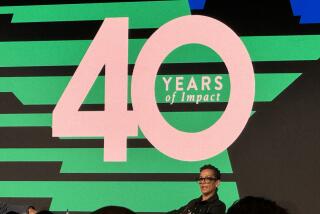Athletes, artists and celebrities create unique logos for the 2028 L.A. Olympics
Nothing about Steven Harrington’s art makes you think of sports. Not the psychedelic-pop aesthetic with its bright, swirling colors or the cartoonish images of grinning palm trees and dancing dogs.
So it took Harrington by surprise when Olympic officials called to ask if he might be interested in creating a logo for the 2028 Summer Games in Los Angeles.
“It came from out of nowhere,” he said. “I was like, is this real?”
The Southern California artist and designer wasn’t the only one asking that question.
LA28 organizers put out dozens of calls, looking for help in unexpected places. They enlisted singer Billie Eilish and actress Reese Witherspoon, as well as a streetwear designer, a chef and a tattoo artist. They also recruited prominent athletes.
“Everyone is part of the L.A. story,” said Janet Evans, an executive with the organizing committee and a five-time Olympic medalist in swimming. “The best way to capture the energy of Los Angeles and the Games is through a collection of voices.”

Each collaborator was given a standard “LA28” logo and told to craft their own version of the “A.” Instead of choosing one design, organizers will use all 26, with more expected in the future.
It might not seem like a big deal — not when organizers have stadiums, arenas and an estimated $7-billion budget to worry about — but the process generated something stylized and highly individual, which makes it an oddity in an Olympic world that is usually conservative and protective of its brand.
LA28 chairman Casey Wasserman referred to nudging the International Olympic Committee “a little out of its comfort zone.” Olympic officials said they were prepared.
“We knew they were going to come up with something different,” said Nicole Hoevertsz, an IOC executive overseeing the 2028 Summer Games.
Paris was the first host city to create a logo, in 1924. Since then, the history of Olympic logos, or emblems, encompasses a range of styles from traditional to modern, conventional to abstract.
London stuck with a black-and-white line drawing in 1948. Helsinki shifted to a bold, blue image in 1952. Mexico City borrowed from folk art in 1968 and Munich chose spiraling geometry for the 1972 Summer Games.
L.A. organizers started pondering the logo for their Olympics and Paralympics almost two years ago. They needed something to fit a unique circumstance — the dual-award that saw Paris chosen for 2024 and L.A. agree to wait another four years. The iconography would have to emphasize the city’s diversity while also, somehow, staying fresh for eight years.
“We struggled for a while with this tension between traditional emblems in all of sports, which are static, and L.A., which is a dynamic, changing city,” Wassermann said, adding: “When you ask people what Los Angeles represents, you’ll get a lot of answers.”
A basic template that allowed for infinite interpretations seemed to fit the bill, so organizers began soliciting contributors.
The list soon grew to include famous athletes such as sprinter Allyson Felix, snowboarder Chloe Kim and gymnast Gabby Douglas. Paralympians such as long jumper Lex Gillette and sprinter Scout Bassett signed on.
But what made the project unusual were the outsiders, an eclectic group that featured graffiti artist Chaz Bojorquez and chef Jorge “Joy” Alvarez-Tostado, the city’s renowned taquero.
Some of these creative types were just old enough to remember the 1984 Summer Games in L.A., but it wasn’t necessarily the athletic performances that stuck in their minds. They recalled the logo with its bold, red-white-and-blue stars and the ubiquitous street banners colored bright orange and purple.
“I just think the artwork spilled into Los Angeles culture in the years to follow,” Harrington said. “To this day, a lot of those graphics you still see.”
The official mascot in 1984, “Sam the Eagle,” was created by Disney and made an impression on a young Bobby Kim, who recalls: “To have this friendly, cartoon-type of a mascot for the Olympics was very ’80s and also very Hollywood and very American.”
Now known as Bobby Hundreds, the L.A. native has become successful designing graphic T-shirts and hoodies for the Hundreds streetwear brand. For the Olympic logo, he incorporated flowers and interlocking hands of various colors.
“What is the strength of our city?” he asked. “Everybody looks different, thinks differently, eats different food. I really wanted to reflect that.”
The artists weren’t given total freedom; they had to adhere to a set of guidelines related to size, shape and color, among other things. These restrictions weren’t a problem for Dr. Woo.
The L.A. tattoo artist has a celebrity clientele that includes Drake, Zoe Kravitz, Emilia Clarke and Miley Cyrus. Also athletes such as boxer Canelo Alvarez and basketball players Kevin Durant and Blake Griffin.
“When you’re working with people’s skin and the designs they want, obviously there is a pretty defined guideline,” Woo said. “You give me some space and tell me where I can do my thing, and I will.”
Woo created his “A” using the dark, intricate lines that distinguish his tattoos. “It’s a grid, almost like a map and a diagram to figure something out,” he said. Other artists brought their styles to bear.
Eilish went with bright green, like her dyed hair, and Bojorquez employed a typography to honor the tradition of the cholo. Harrington made use of his distinctive palm tree, with its head leaning forward.
“I wanted to represent that moment when a runner breaks through their wall,” he said. “That kind of runner I wanted to metaphorically take on the form of Los Angeles itself.”
The creative process was different for athletes, who paired with professional designers. Swimmer Simone Manuel wanted something that symbolized her life in the water and her desire to be bold and strong as a Black woman. The designer came up with a crashing wave.

“It was really about talking a lot,” said Manual, a four-time Olympic medalist. “It was interesting to see the process unfold creatively.”
Over the next eight years, the 26 versions will be interchanged depending on circumstance and platform. They will be animated for video and digital uses and more will be added to the mix in the future.
If the results are unusual, by Olympic standards, the IOC doesn’t seem to mind.
“When we saw it, we were very impressed with the level of creativity,” Hoevertsz said. “It’s something totally different than any other Games have had before.”
More to Read
Go beyond the scoreboard
Get the latest on L.A.'s teams in the daily Sports Report newsletter.
You may occasionally receive promotional content from the Los Angeles Times.







